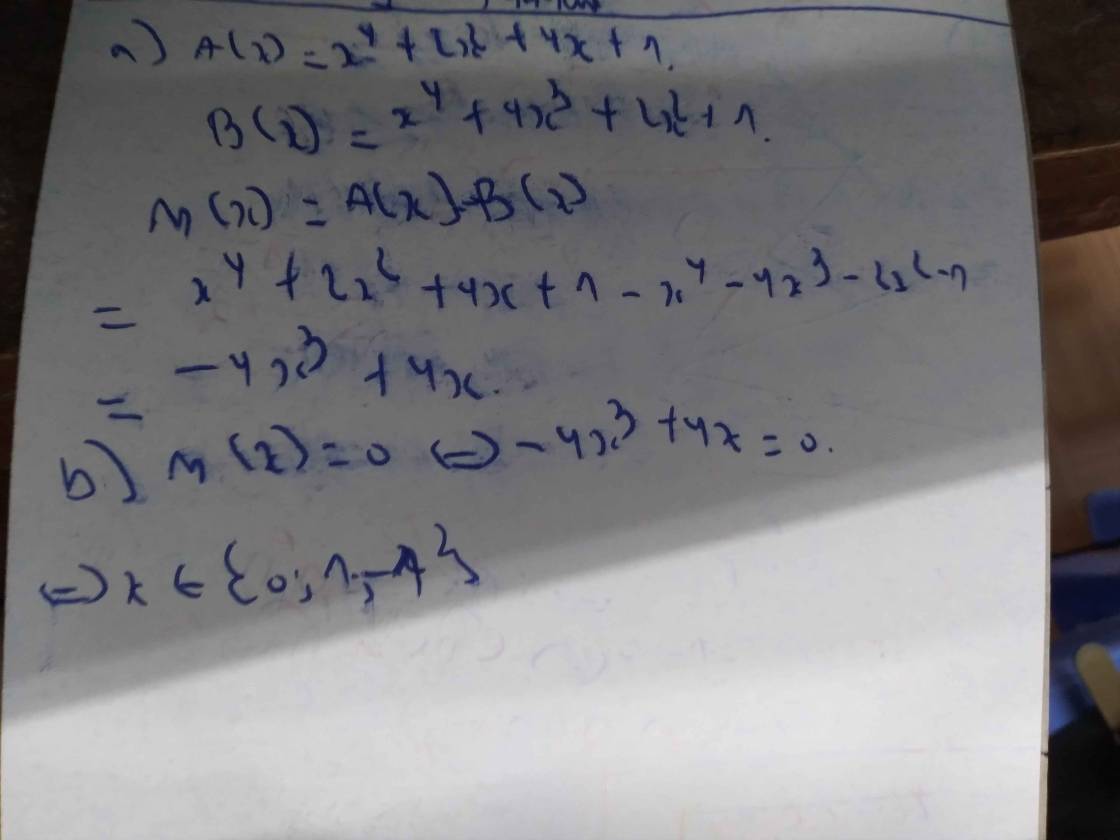
Hãy nhập câu hỏi của bạn vào đây, nếu là tài khoản VIP, bạn sẽ được ưu tiên trả lời.


a) \(-3x^3+5x^2-2x=0\\ \Leftrightarrow3x^3-5x^2+2x=0\\ \Leftrightarrow x\left(3x^2-5x+2\right)=0\\ \Leftrightarrow x\left(3x-2\right)\left(x-1\right)=0\\ \Leftrightarrow\left[{}\begin{matrix}x=0\\x=\dfrac{2}{3}\\x=1\end{matrix}\right.\)
Vậy tập nghiệm của phương trình là \(S=\left\{0;\dfrac{2}{3};1\right\}\)
b) \(\dfrac{-1}{2}x^4+\dfrac{1}{8}x^2=0\\ \Leftrightarrow\dfrac{-1}{2}x^2\left(x^2-\dfrac{1}{4}\right)=0\\ \Leftrightarrow\dfrac{-1}{2}x^2\left(x-\dfrac{1}{2}\right)\left(x+\dfrac{1}{2}\right)=0\\ \Leftrightarrow\left[{}\begin{matrix}x=0\\x=\dfrac{1}{2}\\x=-\dfrac{1}{2}\end{matrix}\right.\)
Vậy tập nghiệm của phương trình là \(S=\left\{0;\dfrac{1}{2};\dfrac{-1}{2}\right\}\)

a) A(x) = 0 ⇔ 6 - 2x = 0 ⇔ x = 3
Nghiệm của đa thức là x = 3
b)1. P(1) = \(1^4+2.1^2+1\) = 4
P(\(-\dfrac{1}{2}\)) = \(\left(-\dfrac{1}{2}\right)^4+2\left(-\dfrac{1}{2}\right)^2+1\) = \(\dfrac{25}{16}\)
Ta có: P(x) = \(\left(x^2+1\right)^2\)
Vì \(\left(x^2+1\right)^2\) ≥ 0
Nên P(x) = 0 khi \(x^2+1=0\) ⇔ \(x^2=-1\) (vô lý)
Vậy P(x) không có nghiệm
a) Đặt A(x)=0
\(\Leftrightarrow6-2x=0\)
\(\Leftrightarrow2x=6\)
hay x=3
Vậy: x=3 là nghiệm của đa thức A(x)

A(x)=4x4−6x2−7x3−5x−6
B(x)=−5x2+7x3+5x+4−4x4
a/ - Tính:
M(x)=A(x)+B(x)
M(x)=4x4+6x2−7x3−5x−6−5x2+7x3+5x+4−4x4
M(x)=x2−2
- Tìm nghiệm:
M(x)=x2−2=0⇔x2=2⇔x=−√2;x=√2
b/ C(x)+B(x)=A(x)⇒C(x)=A(x)−B(x)
C(x)=4x4−6x2−7x3−5x−6−(−5x2+7x3+5x+4−4x4)
C(x)=4x4−6x2−7x3−5x−6+5x2−7x3−5x−4+4x4
C(x)=8x4−14x3−x2−10x−10
cho đa thức : A(x)=4x^4+6x^2-7x^3-5x-6 và B(x)=-5x^2+x^3+5x+4-4x^4
a)Tính M(x)=A(x)+B(x) rồi tính nghiệm của đa thức M(x)
b)tìm đa thức C(x)sao cho C(x)|+B(x)=A(x)


a) choA(x) = 0
\(=>-18+2x=0\)
\(=>2x=18=>x=9\)
b) cho B(x) = 0
\(=>\left(x+1\right)\left(x-2\right)=0\Rightarrow\left[{}\begin{matrix}x=-1\\x=2\end{matrix}\right.\)


a) \(6x^2-2x=2x\left(3x-1\right)\)
\(2x\left(3x-1\right)=0\Leftrightarrow\left[{}\begin{matrix}2x=0\\3x-1=0\end{matrix}\right.\Leftrightarrow\left[{}\begin{matrix}x=0\\x=\dfrac{1}{3}\end{matrix}\right.\)
Vậy \(S=\left\{0;\dfrac{1}{3}\right\}\)
b) \(x^2+5x+6=x^2+2x+3x+6=x\left(x+2\right)+3\left(x+2\right)=\left(x+3\right)\left(x+2\right)\)
\(\left(x+3\right)\left(x+2\right)=0\Leftrightarrow\left[{}\begin{matrix}x+3=0\\x+2=0\end{matrix}\right.\Leftrightarrow\left[{}\begin{matrix}x=-3\\x=-2\end{matrix}\right.\)
Vậy \(S=\left\{-3;-2\right\}\)